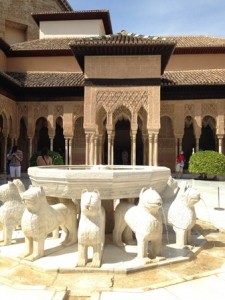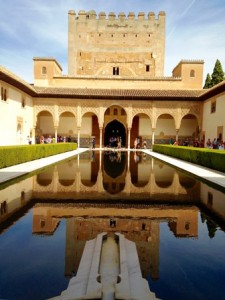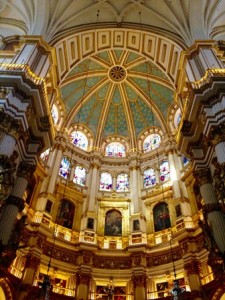
Submitted by Celeste Dilauro on the 2015 fall semester study abroad program in Granada, Spain…
I had never expected to learn so much about a culture in just two weeks. I am living with a host family in Granada, Spain for the fall semester. My host family has been welcoming and makes my roommate and me feel comfortable in their home. During my first three weeks in Granada, I am taking one intensive Spanish course, and my other classes will begin in October. The course combines a formal lecture with tours of landmarks around the city. I like that we have the opportunity to learn outside of the classroom, especially because Granada has such a rich history.
Last week, we visited the Alhambra. The Alhambra was once a fortress and palace. The Arabs had power in Granada from 711-1492, until the Christians conquered the city. There are many palaces within the Alhambra, some of which have architecture that is Arab influenced and some that is evidently Christian architecture. The buildings with great Arab influence have incredible detail and tend to be constructed of simple materials like plaster. The Christians tended to create palaces that were more ostentatious and decorative. Throughout the Alhambra, there is running water and many fountains. The dominant presence of water allowed Granada to show their power to outsiders.


We also visited the Cathedral and Royal Chapel in the center of Granada. In the Royal Chapel are the tombs of Queen Isabel and King Fernando, in addition to their daughter Juana and son-in-law Felipe. Queen Isabel loved Granada and wanted to be buried here, rather than the Escorial, a royal burial site just outside of Madrid. I am beginning to see why Isabel loved Granada so much. It truly is an amazing and beautiful city!

Since my arrival, I have noticed quite a few cultural differences. For example, in Spain, people generally eat a light breakfast, a large lunch at 3:00 pm and a light dinner at 10:00 pm. It has been challenging to adjust to this eating schedule, but I think it’s overall a healthier way to eat. In class, we discussed some of the cultural norms we had observed. Another major cultural difference is that Spaniards tend to be very forward and honest. For example, if you have gained or lost weight, it is very likely that your host parent will bring it to your attention. I have not yet experienced this, but I have noticed that my host parents are very honest and encourage open conversation.
